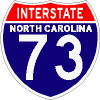On September 12, 2015 MassDOT posted an advertisement calling for bids on a contract (Project No. 608024) that will convert the state's interstates an other US and State Route expressways to the Geographic Reference Location or Milepost Exit Numbering System starting in 2016. The winning bidder is to be chosen on November 17, 2015. This ends a process started with the 2009 Massachusetts Supplement to the federal MUTCD, section 2E.31 stating: "Massachusetts will be changing all its interchange exit signs statewide to the reference location numbering system, with the entire state highway system to be converted to the new numbers over the next five to ten years." According to a MassDOT source, a chief sign engineer, however, when the state approached the FHWA about funding an ongoing conversion project, they insisted the only way Massachusetts could get 90% federal funding was if they did the project all at once, in what is termed a blanket contract. According to the same source, the project will start in the western part of the state and move east. Short routes like I-84 and I-385 probably being the first to receive the new numbers.
When MassDOT committed to the blanket contract for changing the numbers all at once, they already had two projects in the works to update the signage along I-90, the Massachusetts Turnpike, from the NY border to Exit 20 in Allston/Brighton. They decided to change the numbers along I-90 under these two contracts instead. The first project, that will change the numbers from the border east to I-290/I-395 in Auburn was let on August 18. The eastern project is to be advertised on October 31 and will probably be let in December (the remaining signs east of Allston-Brighton date from the extension of I-90 to East Boston in the 1990s and the numbers will be changed under the blanket contract).
I was able to get a copy of the signage plans for the western part of I-90 with the new exit numbers. Heading west to east, the first (currently 1) will become 3:
And the final exit under the contract, now 10, will become 90:
US 20, that was formerly on the Exit 9 signage, will be relegated to a ground-level auxiliary sign:
All the I-90 signs on the Turnpike and Ramp will also feature the Mass Pike Logo:
And a Toll Banner at Turnpike Entrances:
For a complete listing of the new exit numbers for the Mass Pike, go to the Future I-90 Mass Pike Exit List. To see more signing plans, go to the I-90 Sign Plans Gallery.
With Massachusetts converting to milepost based numbering, and Connecticut starting to convert with a project currently going on along I-395 (for a gallery of the new signs already put up, visit this Flickr Site). This only leaves three New England states (NH, RI and VT) plus New York (and Interstates in Delaware) as the only remaining consecutive exit number states. With federal mandates calling for a switch, it probably will only be a short time before these states change as well.
In addition to my I-90 list, feel free also to check out my lists covering probable future exit numbers for all of Massachusetts's Interstates and State Route Expressways.








Comments
On November 28, MassDOT placed an advertisement for bidders for the next Mass Pike signing project from Millbury to Boston (Current Exits 10A to 20). The winning bidder is to be announced on February 2, 2016. Work is to start later in the spring.
http://www.gribblenation.net/mass21/i90photos.html